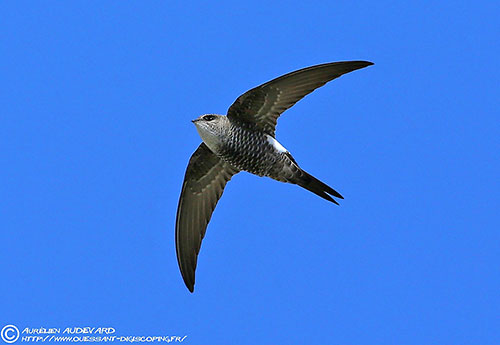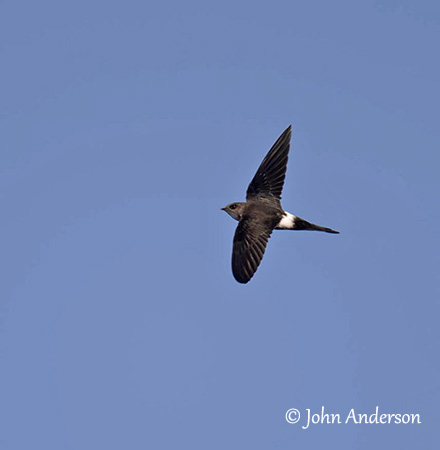
REPRODUCTION OF THIS SPECIES:
The breeding season occurs in March-May in Nepal, in April-July in the Himalayas and in June-August in Japan.
The Pacific Swift is a colonial breeder. It builds a cup-shaped nest with dry grass, feathers and some vegetation collected in flight or from the ground. These materials are cemented with saliva against vertical rock faces in cliffs, in caves or under the eaves of human habitations.
The female lays 2-3 eggs and both adults incubate during 17 days. The chicks are fed on insect balls bound with saliva. However, in bad weather, the chicks are not fed for days, and survive on stored body fat. They fledge about 40 days after hatching.
PROTECTION / THREATS / STATUS:
The Pacific Swift has very large range in which it is described as common, except in Pakistan.
There are no significant threats because predation is low as the nesting sites are usually inaccessible for snakes or mammalian predators.
The size of the population is unknown, but the numbers are suspected to be stable.
The Pacific Swift is not globally threatened and currently evaluated as Least Concern.
Fr: Martinet de Sibérie
Ang: Pacific Swift - Fork-tailed Swift
All: Pazifiksegler
Esp: Vencejo del Pacífico
Ita: Rondone codaforcuta
Nd: Siberische Gierzwaluw
Sd: orientseglare
Photographers:
John Anderson
John Anderson Photo Galleries
Aurélien Audevard
OUESSANT DIGISCOPING
Text by Nicole Bouglouan
Sources:
HANDBOOK OF THE BIRDS OF THE WORLD Vol 5 by Josep del Hoyo-Andrew Elliott-Jordi Sargatal - Lynx Edicions - ISBN: 8487334253
Swifts: A Guide to the Swifts and Treeswifts of the World, Second Edition Hardcover – January 1, 1995 – By Phil Chantler – Pica Press – ISBN: 0300079362 – 978-0300079364 – 237 pages
Thai National Parks - Pacific Swift
Taxonomy of the Pacific Swift Apus pacificus Latham, 1802, complex
What Bird-The ultimate Bird Guide (Mitchell Waite)
Wikipedia, the free encyclopaedia
Pacific Swift
Apus pacificus
Apodiformes Order – Apodidae Family
INTRODUCTION:
The Pacific Swift is the largest member of genus Apus. It breeds in E Asia and winters in SE Asia and Australia. It is strongly migratory and frequents a wide range of habitats.
It typically feeds on insects caught in flight. It nests in caves, rock crevices or under roofs of human habitations. Both parents share the nesting duties. The breeding sites are usually at high elevations, often above 3,000 metres or higher.
The Pacific Swift is described as common in most of its range, with probably stable population. The species is not globally threatened for the moment.
DESCRIPTION OF THE BIRD:
Biometrics:
Length: 17-21 cm
Wingspan: 43-54 cm
Weight: 42-43 g
The Pacific Swift has black upperparts including wings and tail, contrasting strongly with the white band of the rump.
On the underparts, the black feathers show broad, white fringes involving strong scaly pattern. The white rump extends slightly onto the rear flanks. On the underwing, the flight-feathers are slightly paler than above, and may sometimes appear translucent in good light. The wing-coverts are extensively fringed white. The tail is black but slightly paler below.
We can see a broad white throat patch. The head is black-brown with white fringes, more extensive on lores and forehead, and on a line over the eye. There is a black eye-patch. The ear-coverts show faint black-brown fringes. Neck sides may appear slightly paler than the crown.
The bill is black. The eyes are dark brown. Legs and feet are black.

Male and female are similar. Both have long, pointed wings and deeply forked tail. They have a powerful appearance.
The juvenile resembles adult in fresh plumage, but inner primaries and secondaries show narrow white tips.
SUBSPECIES AND RANGE:
The taxonomy of the Pacific Swift is complex. Following examination of the specimens previously recognized as subspecies, both plumage and structural differences indicate that this taxonomy is untenable.
Currently, only two subspecies are recognized, whereas the former subspecies are now elevated to full species status.
We can find:
A.p. pacificus (described above) breeds in Siberia E to Kamchatka and N Japan. It winters in Indonesia, Melanesia, Australia and possibly NE India.
A.p. kanoi occurs in Taiwan, W to SE Tibet to E China. It winters in the Philippines, Indonesia and Malaysia.
This race is blacker than nominate, with smaller throat and rump patches, both mostly greyer and more heavily streaked. The scaly pattern of the underparts may be less distinct. The tail is less deeply forked.
HABITAT:
The Pacific Swift frequents a wide range of habitats, both continental and oceanic, from the low Arctic in north to the Tropics in south.
It is often seen around human habitations. It winters mainly in lowlands, but during summer, it occurs up to 3,800 metres in Nepal, and forages higher, up to 4,000 metres. In Japan, it is present from sea-level to 3,000 metres. Breeding birds are recorded at 2,300 metres in Pakistan, and 3,500 metres in Tibet.
CALLS ANS SONGS: SOUNDS BY XENO-CANTO
The Pacific Swift gives a shrill, piercing scream in flight “srreeeerrrr” usually softer than the call of the Common Swift.
We can also hear lower-pitched single “srree” notes. On the wintering grounds, it produces a variety of twitters and buzzes.
BEHAVIOUR IN THE WILD:
The Pacific Swift typically feeds on insects caught in flight, including various species and mainly Dipterans, but also bees, wasps, termites and moths.
In winter, it forages at higher height than other swifts, usually about 185 metres over wooded areas, and 134 metres over open habitats.
In Siberia, it feeds at dusk for long period, sometimes until midnight. They circle through insect swarms in large flocks of tens or hundreds birds.
The Pacific Swift builds its nests in rocky areas in crevices or caves, but also under the eaves of human habitations. It is a colonial nester. Both parents share the nesting duties.
The nominate race is a long-distance migrant, whereas the race A.p. kanoi is mostly a short-distance migrant.
This species performs fast dashing flight with rapid wingbeats on stiff, swept-back wings, interspersed with glides.
